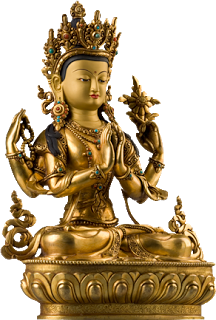The mala bead or the rosary beads in Sanskrit
known as the “Japa Malas” are typically made with 18, 27, 54 or 108 beads. The
important of Mala beads it gives you that focus and concentration on the
mantras we are reciting, prostrations and meditation.
Mala beads or Buddhist rosary beads is a tool that we used for keeping count while reciting,
chanting the number of times, counting the number of prostrations or mentally
repeating a mantra of the name or names of a Buddha, Bodhisattva or
deity.
Tibetans also use their mala for blessing
others, as it is believed the mala absorbs great power through deity mantra
practice. The 108 mala beads is
represents the words or the statements of the Buddha. In some other
schools of Buddhism it means 108
account for human passions or human mistakes.
The mala bead used in
various methods and purposes depend on the mantras used, and mala beads are made from a
variety of materials, most commonly wood. Preferred woods are sandalwood or
sacred wood from the bodhi tree.
More expensive
rosaries beads are made of precious and semi-precious stones, including pearls,
rubies, crystal, amber, coral, or jade, or precious metals such as gold. They
can also be made of seeds, animal bone (most commonly yak), and sometime even
human skull.
Mala beads that made of skull have the important principle
and function. While the wrathful skull images in Tibetan Buddhism may seem scary, and
the skulls are simply reminders of our mortality. Tibetans use skull beads
and jewelry to remind them of impermanence.
Skull mala beads help users contemplate the meaning of
life and death during meditation. The Skull is reflects on death and impermanence and know that death is a fact and the closer that we can relate to death and embrace it the sooner we can start living with love and compassion and realizing that in this cyclic existence death will certainly when it is time. Live life and embrace death. Recognition is the answer to the unavoidable passing of time and body.
In general, the traditional mala beads are
used for all kind of purposes and for all kinds of mantras. The string that holds the beads together is
usually made of silk, but is sometimes made of human hair. The
materials and colors of the beads can relate to a specific practice.
Mantras
and chants are typically repeated hundreds or even thousands of times. The mala
bead is used so that one can focus on the meaning or sound of the mantra rather
than counting its repetitions.
One repetition is usually said for each bead
while turning the thumb clockwise around
each bead, when arriving at the Guru bead or the center bead; Tibetan Buddhists traditionally turn
the mala around and then go back in the opposing direction. [I don’t cross over
the Guru bead as advised by my Guru] but, some emphasize that this is not
important.
This repetition of the beads serves to remind practitioners of the
teaching that it is possible to break the cycle of birth and death. Recite a
very large number of mantras, Tibetan Buddhist males have bell and dorje
counters (a short string of ten beads, usually silver, with a bell or dorje at
the bottom).
These counters are placed at different points
on the mala depending on tradition, sometimes at the 10th, 21st or 25th bead
from the Guru bead. Traditionally, one begins the mala in the direction of the
dorje (skillful means) proceeding on to the bell (wisdom) with each round.
In the Vajrayana traditions, the Tibetan Buddhists generally used the left hand for reciting or using the mala beads, and as well using a certain
fingers, and either pushing or pulling each bead has a specific purpose and
characteristic – whether for healing, protection, wealth, etc.
Prayer beads are the attributes of certain
Buddhist deities, an example is the four arms Chenrezig is often
depicted holding a lotus and another hand is holding the rosary of 108 mala beads
that representing the Bodhisattva's wish to help sentient beings conquer the
108 passions and attain enlightenment.
Thank you for
reading and may you find peace and great bliss. With your support it helps
spread the Buddha’s precious teachings and turning the Dharma wheels in the
world.
Aspiration For
Bodhichitta
May the
precious Bodhichitta arise
Where it has
not arisen
And where it
has arisen may it not decrease
But increase
further and further.
Nagarjuna's
Dedication of Merit
By this merit
may we obtain omniscience then.
Having
defeated the enemies wrong-doings.
May we
liberate migrators from the ocean of existence.
With its
stormy waves of birth, old age, sickness and death.
*Note*
I do not own
or infringe any copyright of these pictures.Pictures
courtesy and credit to the rightful owners.






No comments:
Post a Comment
Note: Only a member of this blog may post a comment.